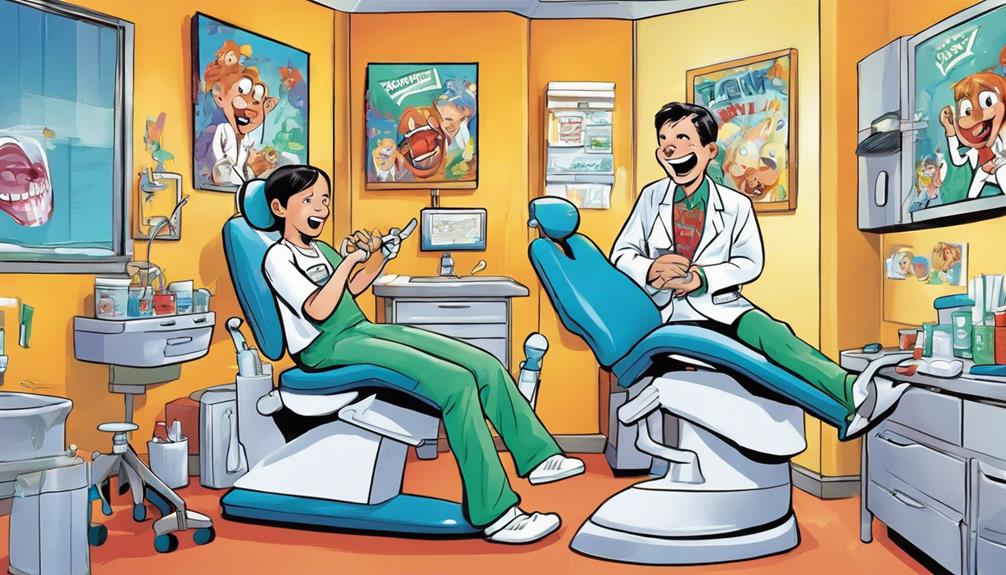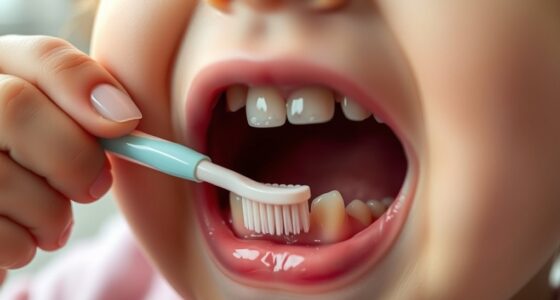You should never let your kids brush their teeth right after breakfast because it can damage their enamel. After eating, especially acidic foods, their enamel becomes softened, making it vulnerable. Brushing too soon can wear it down and increase the risk of cavities and sensitivity. Instead, waiting 30 to 60 minutes allows their saliva to neutralize acids and restore pH balance, protecting their teeth. Encourage your kids to rinse with water or chew sugarless gum in the meantime. Discovering more about their dental health habits could help guarantee a brighter smile for life.
Key Takeaways
- Brushing immediately after breakfast can damage softened enamel, increasing the risk of tooth sensitivity and cavities.
- Acidic foods can lower mouth pH, making enamel vulnerable to erosion, which brushing can exacerbate.
- Waiting 30-60 minutes allows saliva to neutralize acids and promote natural remineralization of teeth.
- Rinsing with water or chewing sugarless gum can help neutralize acids before brushing.
Importance of Enamel Protection

Protecting enamel is fundamental because it acts as a shield against decay, but it can easily be damaged by the acids in breakfast foods. Foods like citrus fruits and juices, while healthy, can lower the pH balance in your mouth, creating an acidic environment that threatens your enamel. When you consume these acidic foods, your enamel softens, making it more vulnerable to erosion.
Brushing your teeth immediately after eating can do more harm than good. The bristles of your toothbrush can wear away the softened enamel, leading to increased sensitivity and a higher risk of cavities. Instead, it's important to wait at least 30 minutes after breakfast. This gives your saliva time to neutralize the acids and restore your mouth's pH balance, creating a safer environment for your enamel.
Educating your kids about this concept is significant. When they understand that enamel needs protection, they're more likely to adopt better brushing habits. By waiting to brush, they can help maintain their enamel's integrity, ensuring healthier teeth in the long run. Remember, a little patience goes a long way in preserving their smiles!
Understanding Mouth Ph Levels

Understanding mouth pH levels is essential for maintaining dental health, especially after enjoying acidic breakfast foods that can disrupt this balance. When you eat acidic foods, the pH in your mouth can drop below 5.5, which is concerning because that's the threshold where tooth enamel begins to demineralize. Ideally, a healthy mouth maintains a pH level between 6.7 and 7.5.
After consuming these foods, your saliva plays a significant role in rebalancing mouth pH levels. It works to neutralize the acids and restore a healthier environment, which can take about 30 to 60 minutes. If you brush your teeth immediately after eating, you risk damaging your already softened tooth enamel, as it's more vulnerable in this acidic state.
It's important to educate kids on the importance of waiting before brushing. Allowing saliva to do its job helps protect their enamel and promotes better long-term dental health. By understanding the significance of mouth pH levels, you can help create healthy habits that keep their smiles bright and strong.
Risks of Immediate Brushing

Brushing your teeth right after breakfast can actually worsen enamel damage caused by acidic foods. When you eat, especially acidic foods, the pH in your mouth drops, weakening your enamel. If you brush your teeth immediately after eating, you risk further harming this already vulnerable enamel.
Here are three significant risks:
- Increased Tooth Sensitivity: Abrading weakened enamel makes your teeth more sensitive to hot and cold stimuli, causing discomfort.
- Higher Cavity Risk: Brushing immediately can wear away enamel, making it easier for cavities to form, especially in children who are already prone to dental issues.
- Disrupted Remineralization: Your saliva works to neutralize the acids and remineralize your teeth. Brushing right away interrupts this natural healing process, leaving your teeth more susceptible to damage.
Recommended Waiting Period

Waiting at least 30-60 minutes after breakfast before brushing your teeth is essential for preserving enamel health and ensuring your smile stays bright. When you consume acidic foods, your mouth's pH drops, temporarily softening the enamel. Brushing too soon can lead to enamel erosion, which can have long-term effects on your dental health.
Here's a quick breakdown of how long you should wait based on your breakfast choices:
| Food Type | Recommended Wait Time | Effect on Enamel |
|---|---|---|
| Acidic Fruits | 30-60 minutes | Softens enamel |
| Citrus Juices | 45-60 minutes | Increases acidity |
| Sugary Cereals | 30-60 minutes | Promotes bacteria growth |
| Toast & Butter | 30 minutes | Minimal acidity |
| Dairy Products | 30 minutes | Neutral impact |
Allowing saliva to neutralize harmful acids is vital for protecting enamel integrity. Educating your kids about this waiting period not only benefits their dental health but also helps establish lifelong oral care habits. Remember, a little patience goes a long way for a healthy smile!
Alternative Oral Care Practices

After breakfast, rinsing with water can be a simple yet effective way to protect your child's teeth from acid damage.
You might also consider encouraging them to chew sugarless gum, as it boosts saliva production and helps neutralize harmful acids.
These alternative practices can play a big role in maintaining strong dental health for your kids.
Rinsing With Water
Rinsing with water right after breakfast can effectively neutralize mouth acids and protect your teeth from enamel erosion. When you consume acidic foods, like citrus fruits or soda, the acids linger in your mouth, increasing the risk of enamel damage. A quick rinse helps mitigate this risk while also stimulating saliva production, which is essential for restoring your mouth's natural pH balance.
Here are three benefits of rinsing with water after breakfast:
- Neutralizes Acids: It helps wash away harmful acids, reducing the chance of enamel erosion.
- Cleanses the Mouth: Rinsing can remove food particles and sugars, decreasing bacterial growth and plaque formation.
- Promotes Saliva Flow: Increased saliva helps in natural remineralization, providing ongoing enamel protection.
For best enamel protection, wait at least 30 minutes after rinsing before brushing your teeth. This allows your saliva to work its magic, ensuring your teeth are better protected against any remaining acids from your breakfast.
Rinsing with water is a simple yet effective oral care practice that can greatly benefit your dental health.
Chewing Sugarless Gum
While rinsing with water is beneficial, chewing sugarless gum offers another effective way to boost your oral health after meals. When you chew sugarless gum, it stimulates saliva production, which helps neutralize acids in your mouth and promotes a healthier pH balance. This increased saliva is rich in essential minerals that aid in the remineralization of enamel, making chewing gum a great practice for maintaining oral hygiene.
Additionally, sugarless gum helps remove food particles stuck between your teeth, reducing the risk of plaque buildup without the abrasive effect of brushing your teeth after breakfast. The act of chewing also increases blood flow to your gums, enhancing overall gum health and potentially lowering your risk of gum disease.
Many sugarless gums contain xylitol, a natural sweetener that inhibits the growth of cavity-causing bacteria. So, after breakfast, instead of rushing to brush your teeth, consider popping a piece of sugarless gum. It's a simple, effective way to support your oral hygiene routine and keep your smile healthy throughout the day.
Benefits of Pre-Breakfast Brushing

Brushing your teeth before breakfast not only removes overnight bacteria but also helps protect your enamel from acidic foods. This simple routine is vital for maintaining strong dental hygiene.
Here are three key benefits of brushing right before you eat:
- Plaque Prevention: By brushing before breakfast, you get rid of bacteria and plaque that build up overnight, preventing additional plaque formation throughout the day.
- Enamel Protection: Using fluoride toothpaste creates a protective barrier on your enamel, greatly reducing the risk of damage from acidic breakfast foods like orange juice or cereal.
- Enhanced Taste: Brushing in the morning enhances your taste perception, allowing you to enjoy your breakfast foods even more. You'll appreciate a fresher start to your day!
Establishing a routine of pre-breakfast brushing encourages consistent dental hygiene, setting a positive tone for your oral health.
Timing and Frequency of Brushing

To maintain ideal dental health, it's important for kids to understand the right timing and frequency for brushing their teeth. Ideally, you should brush twice a day—once in the morning and once before bed.
However, timing matters, especially after breakfast. If you eat acidic foods, like oranges or yogurt, wait at least 30 minutes before brushing your teeth. This allows saliva to neutralize the acids, protecting your enamel from damage that can occur from immediate brushing.
Brushing your teeth right after breakfast might seem like a good idea, but it can actually harm your teeth. Establishing a consistent routine helps reinforce good habits, so try to make morning brushing happen before breakfast. This way, you'll shield your enamel from acidic exposure.
Evening brushing is also essential. It removes food particles and plaque that accumulate throughout the day, contributing to better overall dental health.
Teaching kids the importance of waiting to brush after meals enhances their understanding of oral hygiene and enamel protection. By following these guidelines, you're setting the stage for a lifetime of healthy smiles.
Choosing the Right Toothbrush

When picking a toothbrush for your child, you want to focus on a few key factors.
Soft bristles can protect their enamel and gums, while a small head helps reach those tricky spots.
You might also consider whether an electric toothbrush could make brushing more fun and effective for them.
Soft Bristle Benefits
Choosing a soft-bristled toothbrush can greatly enhance your oral care routine by effectively cleaning teeth while protecting your enamel and gums. Unlike hard bristles, soft bristles minimize the risk of damaging your enamel, which can weaken over time with aggressive brushing.
Here are three key benefits of using a soft-bristled toothbrush:
- Gentle yet Effective Cleaning: Soft bristles can remove plaque without causing harm to sensitive gums or weakened enamel.
- Comfortable Brushing Experience: Studies show that users of soft-bristled brushes report less discomfort and enjoy better overall dental health compared to those using harder brushes.
- Access to Hard-to-Reach Areas: Soft bristles can easily navigate crevices between teeth, ensuring thorough cleaning without the abrasiveness associated with harder bristles.
Proper Toothbrush Angle
Positioning your toothbrush at a 45-degree angle to your gums guarantees effective plaque removal and promotes healthier teeth and gums.
When you choose a soft-bristled toothbrush, you confirm that you're cleaning your child's teeth without causing damage to the enamel or gums. This gentle approach is vital, especially for young ones whose teeth are more delicate.
Using this proper toothbrush angle, be certain to employ a gentle circular motion while brushing. This technique helps avoid brushing too harshly, preventing gum recession and enamel erosion. It's essential to teach your child how to brush correctly from an early age to establish good habits.
Moreover, always choose a toothbrush that fits comfortably in your child's mouth. A properly sized toothbrush allows for better maneuverability, making it easier to reach all areas of the mouth.
Don't forget to replace the toothbrush every three to four months or sooner if the bristles show signs of wear. Regularly updating the toothbrush confirms effective cleaning and helps maintain good oral hygiene practices.
Electric Vs. Manual
Deciding between an electric or manual toothbrush can greatly impact your child's oral hygiene routine. Here are three key points to take into account:
- Plaque Removal: Electric toothbrushes provide a consistent brushing motion, effectively removing plaque. This is especially beneficial for kids who may not yet have mastered proper brushing techniques.
- Built-in Timers: Many electric toothbrushes come with timers that encourage children to brush their teeth for the recommended two minutes. This helps establish healthy habits early on.
- Pressure Sensors: Some electric models include pressure sensors that alert children if they're brushing too hard. This feature helps prevent enamel erosion, as brushing too aggressively softens the enamel and can harm gums.
When choosing the right toothbrush, remember to opt for soft-bristled heads for both electric and manual options. This minimizes the risk of damage to the enamel and gums, ensuring effective cleaning without causing harm.
Ultimately, whether you choose an electric toothbrush or a manual one, the key is to encourage your child to brush their teeth twice a day for ideal oral health.
Educating Kids on Dental Health

Teaching kids about dental health is essential for fostering lifelong habits that protect their smiles.
Start by explaining how acidic foods, like citrus fruits and certain breakfast cereals, can temporarily weaken the enamel on their teeth and mouth. Emphasize the importance of waiting at least 30 minutes after eating before brushing, as this helps shield their enamel from damage.
Encourage your child to recognize the effects of sugary and acidic breakfast options on their dental health. This knowledge can empower them to make better food choices. Share fun facts about enamel, like how it's the hardest substance in the body; this can make learning about dental care more engaging.
You can also teach them how saliva naturally neutralizes acids and helps remineralize their teeth. Encourage rinsing their mouths with water or chewing sugar-free gum after breakfast to reinforce good dental habits until they can brush safely.
Regular Dental Check-Ups

Ensuring your child has regular dental check-ups is essential for maintaining their oral health and catching potential problems early. These visits help monitor enamel health, detect cavities, and prevent erosion. The American Academy of Pediatrics recommends that your child sees a dentist by their first birthday or within six months of their first tooth eruption.
Here are three key benefits of regular dental check-ups:
- Professional Cleanings: During these visits, dental professionals help remove plaque and tartar buildup that regular brushing might miss, ensuring better overall oral health.
- Personalized Advice: Dentists can guide you and your child on proper brushing techniques and dietary choices, particularly after consuming acidic foods, which can weaken enamel.
- Positive Attitude: Early and consistent dental visits foster a positive attitude toward oral health care, helping your child establish lifelong healthy habits.
Frequently Asked Questions
Should Kids Brush Teeth After Breakfast?
You should encourage kids to wait about 30 minutes after breakfast before brushing their teeth. This allows saliva to neutralize acids, protecting enamel and promoting better dental health while avoiding potential damage to their teeth. Encouraging kids to practice good morning dental hygiene is important for their overall health and well-being. In addition to waiting to brush their teeth after breakfast, kids should also be reminded to use a soft-bristled toothbrush and fluoride toothpaste to thoroughly clean their teeth and gums. By establishing these habits early on, kids can maintain healthy teeth and gums for years to come. The best time for kids to brush their teeth is after they have finished eating breakfast and waiting for about 30 minutes. This ensures that their teeth are properly cleaned without risking damage to the enamel. It’s important to remind children to brush their teeth for at least two minutes and to also floss daily to remove any leftover food particles and plaque. By reinforcing these habits, parents can help their children develop good dental hygiene practices that will benefit them for a lifetime.
Is It Bad to Brush Teeth After Eating in the Morning?
Brushing your teeth right after eating is like pouring water on a grease fire—it can do more harm than good. Wait a bit for your enamel to harden again; your smile will thank you later!
Why Should You Not Brush Your Teeth Immediately After Eating?
Brushing your teeth immediately after eating can harm your enamel. It's better to wait at least 30 minutes, allowing saliva to neutralize acids and protect your teeth from damage. Rinse or chew gum in the meantime.
Why Brush Teeth Before Breakfast Instead of After?
Brushing your teeth before breakfast helps remove overnight plaque and bacteria, protects enamel with fluoride, and boosts saliva production. It gives you a fresh start and enhances your taste experience for breakfast foods.
Is Brushing Teeth After Breakfast Harmful for Kids’ Dental Health?
Some parents wonder if kids dentist visit frequency is affected by brushing teeth after breakfast. While it’s important for kids to maintain good oral hygiene, brushing immediately after eating acidic foods can potentially harm the enamel. Dentists may advise waiting 30 minutes after meals before brushing to protect dental health.
Conclusion
So, before you rush to grab that toothbrush after breakfast, pause for a moment.
You might be unwittingly putting your child's enamel at risk. By waiting just a little while, you can protect their precious smile and guarantee their teeth remain strong.
Remember, the right timing can make all the difference. Don't let a hasty habit jeopardize their dental health!
Instead, embrace these simple practices and watch their confidence—and their smile—grow.
What'll you choose?









